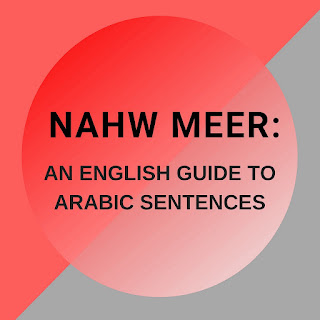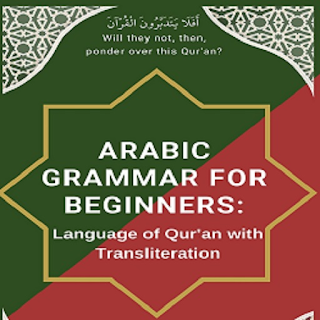Nahw Meer English: 3.1/3.2/3.3/3.4 - Definite/Indefinite/Gender/Quantity
Section 3.1 – Definite/Indefinite Nounsفَصْلٌ ٣. ١ - الْاِسْمُ الْمَعْرِفَةُ وَالنّكِرَة |
Nouns اِسْمٌ are divided into two types: Definite Noun مَعْرِفَةٌ and Indefinite Noun نَكِرَةٌ.
Definite Noun اَلْمَعْرِفَةُ: These Nouns are designed for definite things. These are of seven kinds:
Personal Pronouns اَلضَّمَائرُ also called اَلْمُضْمَرَاتُ.
1. Proper Nouns Names اَلْأَعْلَامُ as in زَيْدٌ وَ عَمْرٌو.
2. Demonstrative Pronouns أَسمَاءُ الِإِشَارَةِ.
3. Relative Pronouns أَسْمَاءُالْمَوْصُوْلَةِ: These are of two kinds and are called اَلْمُبْهَمَاتُ loosely translated as vague, meaning no specific entity is meant.
4. Nouns defined by invocation: As in يَا رَجُلُ meaning “O, man”.
5. Defined by adding letters (ا) and (ل) as in اَلرَّجُلُ meaning “The man”.
6. Defined by use as a Possessed part of the Possessive Compound مُضَافٌ towards one of the 5 kinds defined above in 1-5, in a Possessive Compound الْإِضَافِيْ مُرَكّبُas in غُلَامُهُmeaning “his servant”, غُلَامُ زَيْدٍmeaning “servant of Zaid”, and هٰذَا غُلَامُ meaning “this servant”,
الَّذِي عِنْدِي غُلَامُ meaning “that servant who is with me”, and غُلَامُ الرَّجُلِ meaning “servant of that man”.
Indefinite Noun اَلنَّكِرَةُ: These Nouns are for Indefinite or common things as in رَجُلٌ meaning “a man” and فَرَسٌ “a horse”.
Section 3.2 – Masculine/Feminine Genders فَصْلٌ ٣. ٢ – الْاِسْمِ الْمُذَكَّرُ وَالْمُؤَنَّثُ |
A Noun اِسْمٌ is divided into two genders: Masculine مُذَكَّرٌ and Feminine مُؤَنَّثٌ.
Male اَلْمُذَكَّرُ: This Noun اِسْمٌ is where you will not find any signs of the Feminine Gender as in رَجُلٌ.
Female اَلْمُؤَنَّثُ: This Noun اِسْمٌ is where you will find one of the Signs of the Female Gender as in اِمْرَأَةٌ meaning “a woman”. There are four Signs of the Female Gender:
1) Alphabet round ta ة or تَاءُالتَّانِيْثِ at the end as in طَلْحَةُ. This is a male name but has ة at the end which is an exception. Also, note that a true male will be treated as male even if it has a female gender sign at the end.
2) Al alif-ul maqsoorah اَلْأَلِفُ الْمَقْصُوْرَةُ which is (ىٰ) at the end as in حُبْلَىٰ.
3) Al alif-ul mamdoodah اَلْأَلِفُ الْمَمْدُوْدَةُ which is (اء) at the end as in حَمْرَاءُ.
4) At ta-ul muqaddarah (hidden alphabet ة) الْمُقَدَّرَةُ اَلْتَّاءُ as in اَرْضٌ meaning “earth” and its original was أَرْضَةٌ and its diminutive version is أَرِيْضَةٌ and diminution of an اِسْمٌ returns it to its original three alphabets ثُلَاثِيْ (trilateral) and this is named as Female Gender as heard from or spoken by Arabs مُؤَنَّثًا سَمَاعِيًا.
Section 3.3 – True/Figurative Feminine فَصْلٌ ٣. ٣ – مُوْنَّثٌ حَقِيْقِيٌّ وَلَفْظِيٌّ |
Feminine Gender اَلْمُوْنَّثُ is of two kinds: True حَقَيْقيٌّ and Figurative لَفْظِيٌّ.
True Feminine Gender مُوْنَّثٌ حَقَيْقيٌّ: It has a male gender as an opposite in humans or animals as in اِمْرَأَةٌ meaning “a woman” since it has an opposite male رَجُلٌ meaning “a man”, and نَاقَةٌ meaning “a female camel” and its male is جَمَلٌ meaning “a male camel”.
Figurative Feminine Gender لَفْظِيُّ مُوْنَّثٌ: It does not have a male gender as opposed to humans or animals as in ظُلْمَةٌ meaning “darkness” and قُوَّةٌ meaning “strength/power/force”.
Section 3.4 –Singular/Dual/Plural Nouns فَصْلٌ ٣. ٤ – الْمُفْرَدُ وَالْمُثَنّٰى وَالْجَمْعُ |
Nouns اِسْمٌ are classified in three ways: Singular مُفْردٌ, Dual مُثَنّٰى, and Plural جَمْعٌ.
Singular اَلْمُفْرَدُ specifies a single as in رَجُلٌ meaning “a man”.
Dual اَلْمُثَنّٰى specifies a dual by adding a letter (ا) or a letter (ي) with Fathah, and letter (ن) with kasrah after that, as in رَجُلَانِand رَجُلَيْنِ meaning “two men”, first in the Nominative رَفْعٌ and second in the Accusative نَصْبٌ and Genitive جَرٌّ.
A Pluralاَلْجَمْعُ specifies more than two by changing a Single مُفْردٌ. This is either Mentioned لَفْظًا as in رِجَالٌ, plural for رَجُلٌmeaning “several men” or Assumed/Implicit تَقْدِيرًا based on pattern/scale فُلْكٌ [1]meaning “boats” similar to اُسْدٌmeaning “tigers”. Its singular is also فُلْكٌ. فُلْكٌ is a plural based on the pattern of قُفْلٌ “locks”. See footnote 11.
Mentioned Plurals are of two kinds: Broken plural جَمْعُ الْتَّكْسِيْرِ also called اَلْجَمْعُ الْمُكَسَّرُ and Sound plurals جَمْعُ التَّصْحِيْحِ also called جَمْعُ السَّالِمِ.
A BrokenPlural جَمْعُ الْتَّكْسِيرِ is where the structure of the singular does not remain, as in رِجَالٌ and مَسَاجِدُ. The patterns أَوْزَانٌ for a broken plural for three-letter root word ثُلَاثِيٌّ come from what is heard from an Arabic speaker and there is no room for guessing in it. In a four-letter root word رُبَاعِيٌّ and five-letter root word خُمَاسِىٌّ the broken plural comes from the pattern of فَعَالِلُ as inجَعْفَرٌ to جَعَافِرُ, and جَحْمَرِشُ to جَحَامِرُ by removing the fifth alphabet from it.[2]
A Sound Plural جَمْعُ التَّصْحِيْحِ meaning Unbroken سَالِمٌ: This one is where the structure remains untouched as it was in singular مُفْرَدٌ and these are of two kinds: Sound Masculine Plural جَمْعُ الْمُذَكَّرِ السَّالمِ and Sound Feminine Plural جَمْعُ الْمُؤَنَّثِ السَّالِمِ.
- Sound Masculine Plural السَّالِمِ الْمُذَكَّرِ جَمْعُ: This is where a letter (و) with Dammah (ُ) or letter (ي) with Kasrah (ِ) are added at the end, ahead of letter noon (ن) with Fathah (َ) as in مُسْلِمُوْنَ and مُسْلِمِيْنَ. Both meaning “Muslims”, the first one in the Nominative رَفْعٌ and the second one in both the Accusative نَصْبٌ and Genitive جَرٌّ.
- Sound Feminine Plural جَمْعُ الْمُؤَنَّثِ السَّالِمِ: This is where a letter (ا) and letter (ت) are added at the end as in مُسْلِمَاتُ.[3]
Plural اَلْجَمْعُ is further divided into two types: Small Plural جَمْعُ الْقِلَّةِ for less than 10 and Large Plural جَمْعُ الْكَثْرَةِ for 10 or more.
Lesser Pluralجَمْعُ الْقِلَّةِ for Broken Plural جَمْعُ التَّكْسِيرِ: This is the one where less than ten in number is implied and for this, there are four patterns/scales أَوْزَانٌ:
1) أَفْعُلٌ as in أَكْلُبٌ meaning “dogs”, plural for كَلْبٌ
2) أَفْعَالٌ as in أَقْوَالٌ meaning “sayings”, plural for قَوْلٌ
3) أَفْعِلَةٌ as in أَعْوِنَةٌ meaning “co-operative”, plural for عَوْنٌ
4) فِعْلةٌ as in غِلْمَةٌ meaning “servants”, plural for غُلَامٌ And Sound Plurals without letters (ا) and (ل) are included in Small Plurals, as in:
5) مُسْلِمُوْنَ meaning “Muslims”
6) مُسْلِمَاتٌ meaning “Muslim women”
Large Plural جَمْعُ الْكَثْرَةِ: This plural implies 10 or more and its patterns/scales أَوْزَانٌ are all others, other than the six that have been mentioned above.
۞۞۞
[1] In summary, فُلْكٌ is single and also a plural. The change is assumed mentally. And single فُلْكٌ is based on pattern of قُفْلٌ, and فُلْكٌ plural is based on pattern of اُسْدٌ. They are considered to be dependent on this characterization and Implicit because اَلفُلْكُ comes for both single and plural.
[2] When جَحْمَرِشُwas made a plural, alphabet (ش) was deleted that was fifth alphabet in the single Noun and adding (ا) as in فَعَالِلُ.
[3] The alphabet (ت) was added after deleting the alphabet (ة) which was in the single Noun.




Comments